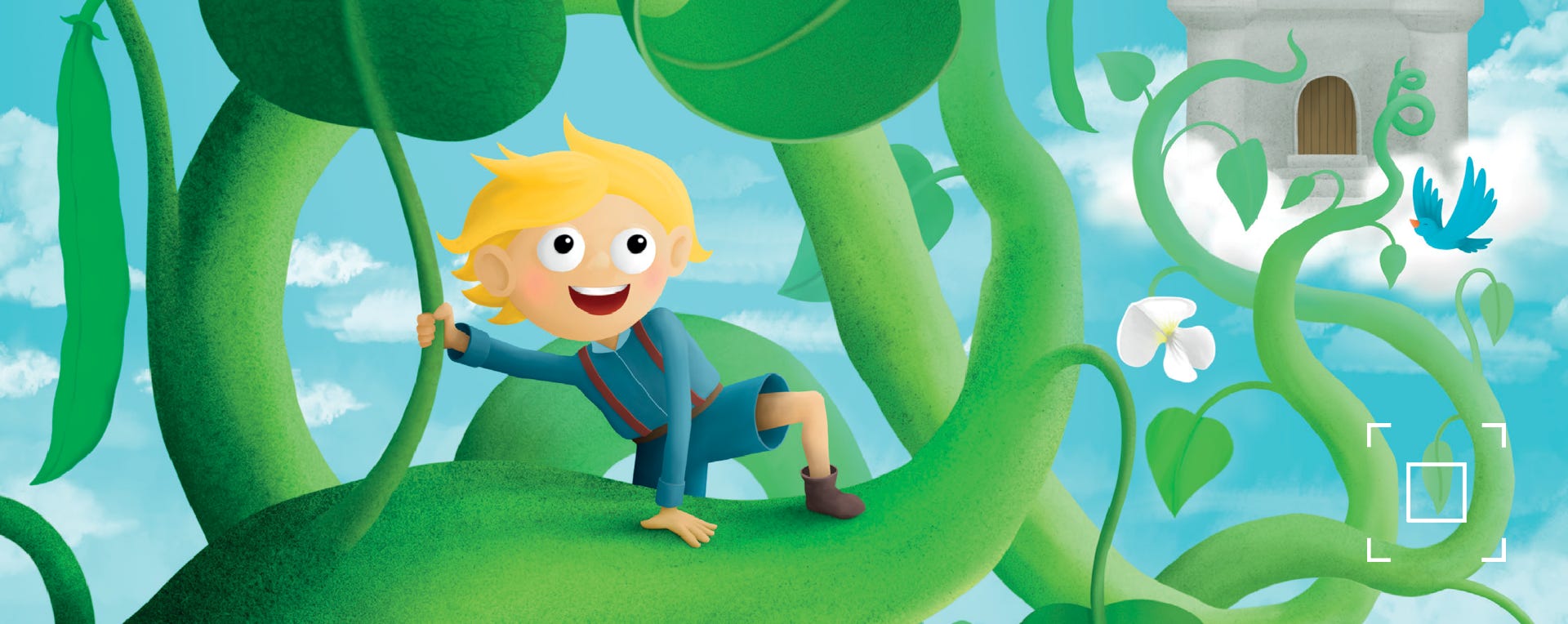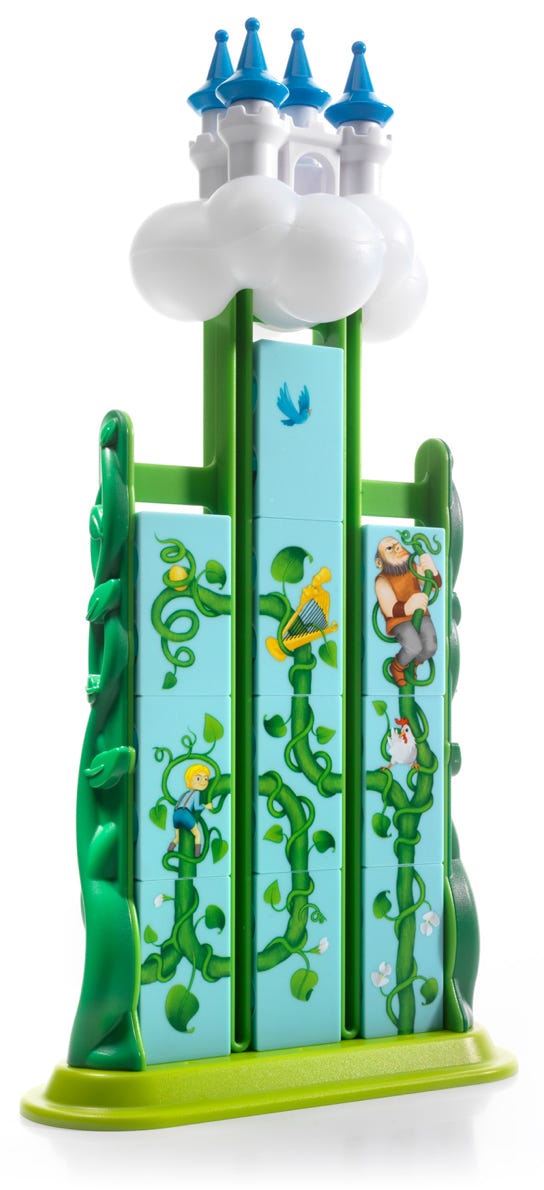
Jack & the Beanstalk
The product development of Jack & the Beanstalk (for SmartGames)
Raf Peeters, August 2020
After designing puzzle games for famous fairy tales, like Three Little Piggies, Little Red Riding Hood, Snow White and Sleeping Beauty I wanted to do something different. Something that caught my imagination as a kid, because it was so fantastic and magical: Jack and the Beanstalk. The idea of climbing a giant beanstalk to reach a castle in the clouds is much more adventurous than being eaten by a wolf or poisoned by a witch. What I also liked is that the main character is a little boy instead of a girl like in most of the other fairy tales I have done so far.
THE SKY IS THE LIMIT!
This fairy tale is better known in English speaking countries than in the rest of Europe, because it’s not one of the tales of the Brothers Grimm or Hans Anderson. But when I choose a theme for a game, I always look at the potential of making it visually striking. And a giant beanstalk with a castle in the clouds on top does look iconic.
In this game I started with the theme and look. It would also make sense that the game included puzzle pieces that you had to stack higher and higher, like a beanstalk that grows. But I wanted to have something more than just a “match the image” game. So I combined it with an old classic wooden toy concept. You know, a figurine in wood that you place on top of a ladder and that drops down. What is nice about this toy, is that the figurine tilts every time that it drop down a step.
I had some past experience with this kind of toys. When I was in my first year of Product Design (in Genk) we had to make a giant toy like that to promote the school at their annual open day. The ladder was build next to an old metal elevator that stood in a central stairway hall. The ladder was several floors high and the wooden egg shaped block about 40 cm high. It made a terrible sound when it started falling down and the biggest technical challenge was to avoid that the block would accelerate and bring down the complete ladder with it.
Fortunately this version of the toy would be a lot smaller. But we had to overcome other technical problems. In the original toy, you only need to drop 1 figurine. For “Jack & The Beanstalk” I wanted to have 10 puzzles pieces that could be stacked on top of each other. The hard part was to make sure that every time you added an extra piece, this last piece would land exactly on the right place. We had to make many prototypes before it worked. Another problem was the opposite. When you removed pieces from the bottom side, sometimes the puzzle pieces on top would block everything. But eventually we got everything working like a charm.
Another concern was to make de ladder strong enough. The cutout inside the puzzle pieces has a very specific shape. Because of this cutout a puzzle piece will only drop down to the next step when it rotates 180°. Therefor you can’t remove any puzzle pieces from the ladders, except on the very top and bottom side. To avoid that children would break the ladders when they tried to do that anyway (you know, children…), we made it impossible by giving the horizontal steps in the ladder a radius.
After we solved all technical issues, I started concentrating on the challenges and the artwork for the puzzle pieces. I wanted to make it possible that you could build different looking beanstalks with the same puzzle pieces. This was like a connection game for me, because artwork on one puzzle piece needed to continue on adjacent ones.
When I was working on this, I realized that it would be very difficult for young children, if the artwork on front and backside would be completely different. Therefor the artwork of the beanstalk parts on both sides is similar, except that it’s mirrored. And sometimes there is a figurine on one of the sides. The advantage is twofold. Firstly, you don’t have to flip over each puzzle piece when you are looking for a specific beanstalk shape. Secondly, when you solve a challenge, the final image on both sides of the ladders will look OK. If the artwork on the puzzle pieces was completely different on both sides, one side would look scrambled. Of course, only the front side will look identical to the challenge.
From a conceptual point of view there are other differences between puzzle pieces. One piece (the straight one) can’t be placed wrong, it does not matter how you put it on top of the ladder. The result will always be the same. But other puzzle pieces have two (left/right or front/back) or four possible orientations. When you try to solve a challenge you have to count how many steps a puzzle piece will fall. If the number of steps is even, you can place your puzzle piece in the same orientation as the final one you need. But if the number of steps is uneven, you need to place the puzzle piece upside-down, with the right artwork on the opposite side. This sounds harder than it is, but don’t forget this game is for young children of age 4 and up. For easy challenges you only need a few puzzle pieces. For hard challenges, you need them all.
The challenges booklet has two sides. One side has challenges with and the other side has challenges without the Giant. This doesn’t make a difference for the game play, but what does make a difference is that there is no white outline shown in the challenges with the Giant. This makes them slightly harder.
The castle on the cloud has no other function than being pretty. Originally I wanted the cloud and the castle to be printed on one of the puzzle pieces. But this didn’t look nice, so we made a separate part of it. You don’t really need it when you solve a challenge, but it does give a satisfactory feeling to place it on top when you solved a challenge.
Like the other fairy tales, this game also includes a picture book with the story, illustrated by my colleague Hans Bloemmen (see illustration for the cover on top of this page). This games is really hard to describe with only images. You need to see it in action. Here is a link to a demonstration movie on the YouTube channel of SmartGames.
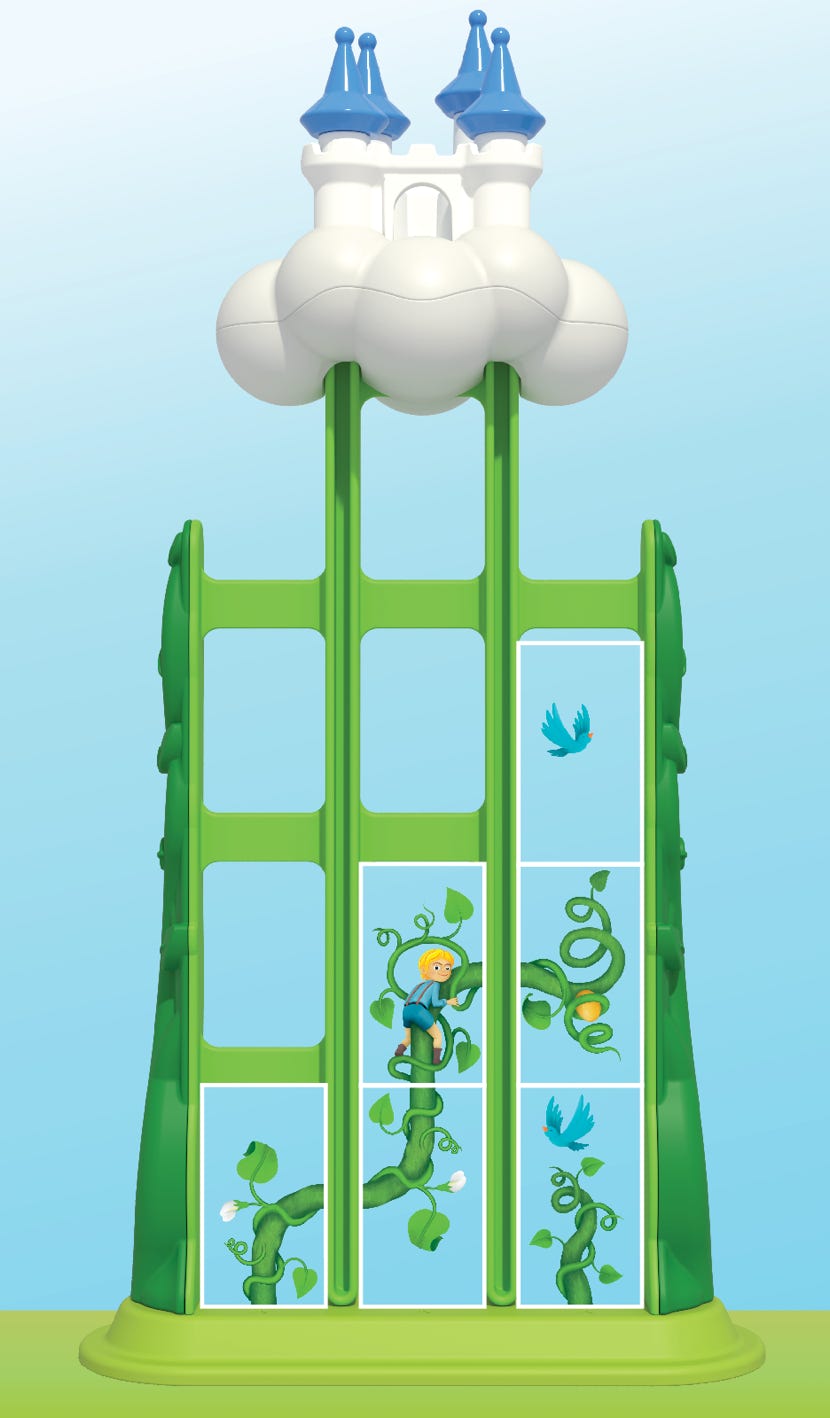
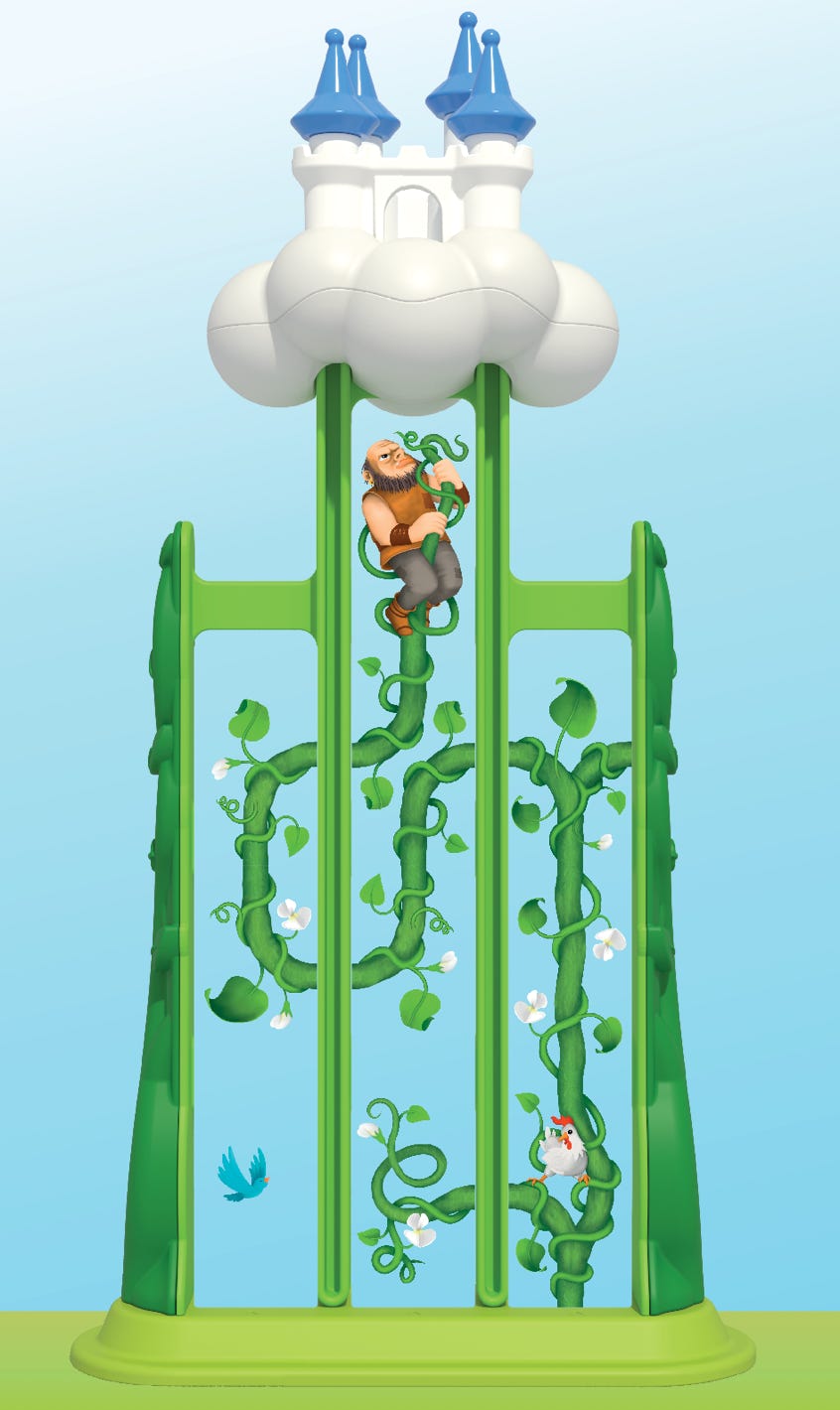
Example of a Junior challenge without the Giant (left) and Master challenge (right) with the Giant.
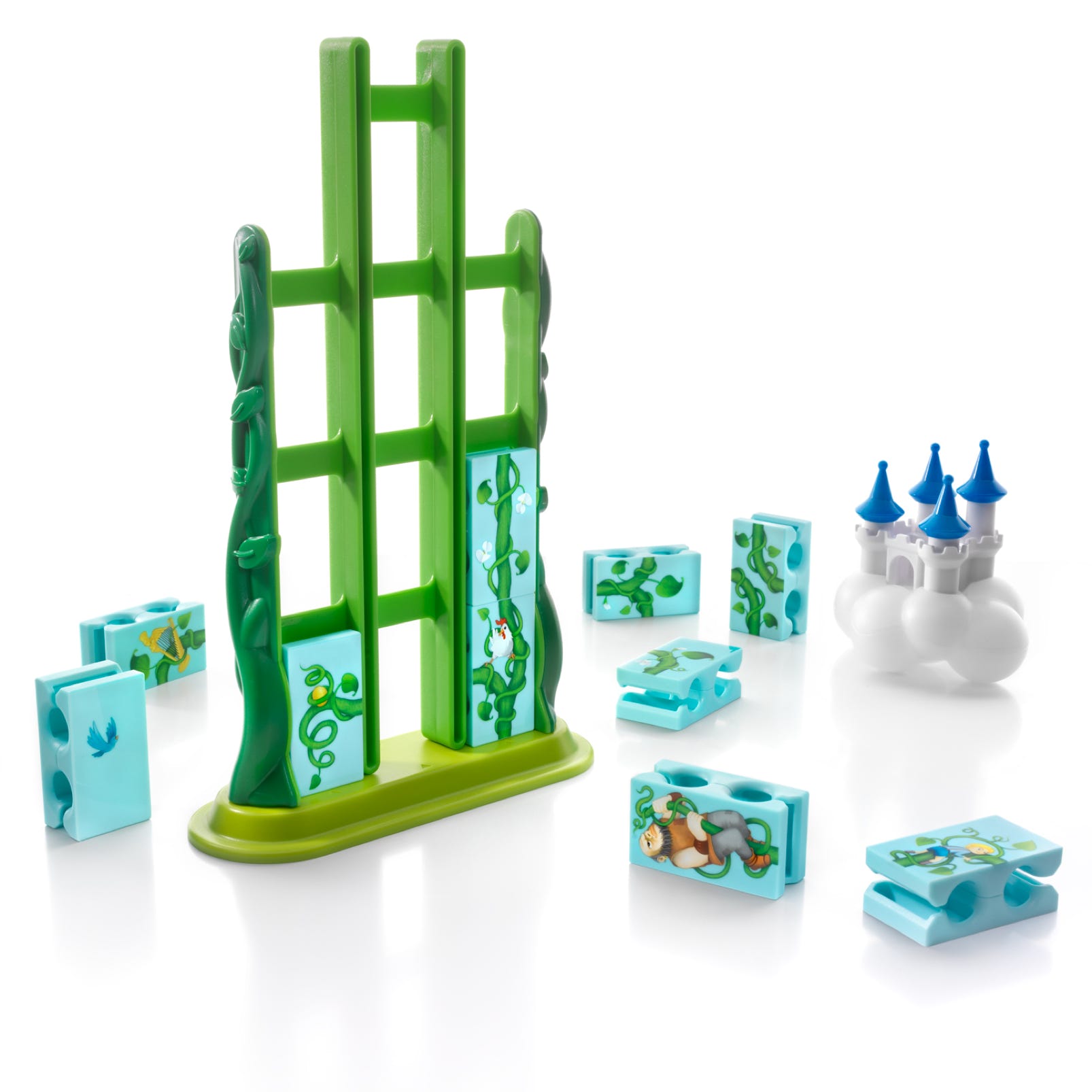
GAME RULES JACK & THE BEANSTALK
Before you start: Remove the castle and cloud from the beanstalk. Remove all playing pieces from the beanstalk by pushing them out one by one at the bottom (indicated by a triangle on the base).
1) Select a challenge.
2) Place the puzzle pieces in the grid of the beanstalk by inserting them on the topside and letting them drop down one-by-one. More difficult challenges require more puzzle pieces. The result must match the image shown in the challenge:
• Pay attention to the initial orientation of each puzzle piece. When a piece drops down it will tilt a number of times. You need to plan the orientation on the topside to make sure it shows the correct artwork when it lands in place.
• Only the frontside (the side facing you) is important for the solution.
• In case you make a mistake, just push out all pieces in that column, one by one at the bottom and start over.
• NEVER try to remove a piece halfway the structure of the beanstalk, because you might risk to damage the ladders or puzzle pieces!
3) You have found the solution when the combined image on the puzzle pieces on the frontside matches the image of the challenge!
Website ©2020 Raf Peeters
Products and images: © Smart
